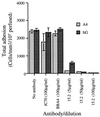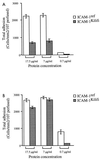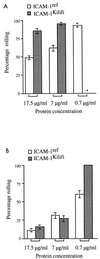Differential binding of clonal variants of Plasmodium falciparum to allelic forms of intracellular adhesion molecule 1 determined by flow adhesion assay
- PMID: 10603397
- PMCID: PMC97130
- DOI: 10.1128/IAI.68.1.264-269.2000
Differential binding of clonal variants of Plasmodium falciparum to allelic forms of intracellular adhesion molecule 1 determined by flow adhesion assay
Abstract
Adhesion of Plasmodium falciparum-infected erythrocytes to the endothelial ligand intercellular adhesion molecule 1 (ICAM-1) has been implicated in the pathogenesis of cerebral malaria. Recently, a high-frequency coding polymorphism in the N-terminal domain of ICAM-1 (ICAM-1(Kilifi)) that is associated with susceptibility to cerebral disease in Kenya has been described. Preliminary static adhesion assays suggested that two different selected P. falciparum lines, ITO4-A4 (A4) and ItG-ICAM (ItG), have different properties of binding to the natural variant proteins ICAM-1 and ICAM-1(Kilifi). Using a flow adhesion assay system, we have confirmed differences between the two lines in binding of parasitized erythrocytes to the variant ICAM-1 proteins. Total adhesion of ItG-infected erythrocytes to ICAM-1 and ICAM-1(Kilifi) is greater than that of A4-infected erythrocytes, and erythrocytes infected by both parasite strains show reduced binding to ICAM-1(Kilifi). However, under these physiologically relevant flow conditions, we have shown differences between A4 and ItG strains in dynamic rolling behavior on ICAM-1(Kilifi). The percentage of erythrocytes infected with A4 that roll on both ICAM-1 and ICAM-1(Kilifi) is greater than that of those infected with ItG. Also, the rolling velocity of A4-infected erythrocytes on ICAM-1(Kilifi) is markedly increased compared to that on ICAM-1, in contrast to the rolling velocity of ItG-infected erythrocytes, which is similar on both proteins. These findings suggest that different parasite lines can vary in their avidity for the same host ligand, which may have important consequences for the pathophysiology of P. falciparum malaria.
Figures





References
-
- Bellamy R, Kwiatkowski D, Hill A V. Absence of an association between intercellular adhesion molecule-1, complement receptor-1 and interleukin-1 receptor antagonist gene polymorphisms and severe malaria in a West African population. Trans R Soc Trop Med Hyg. 1998;92:312–316. - PubMed
-
- Berendt A R, Simmons D L, Tansey J, Newbold C I, Marsh K. Intercellular adhesion molecule-1 is an endothelial cell adhesion receptor for Plasmodium falciparum. Nature. 1989;341:57–59. - PubMed
-
- Berendt A R, McDowall A, Craig A G, Bates P A, Sternberg M J E, Marsh K, Newbold C I, Hogg N. The binding site on ICAM-1 for Plasmodium falciparum-infected erythrocytes overlaps, but is distinct from, the LFA-1 binding site. Cell. 1992;68:71–81. - PubMed
Publication types
MeSH terms
Substances
Grants and funding
LinkOut - more resources
Full Text Sources
Miscellaneous

